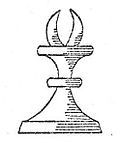History and nomenclature
The elephant (alfil) as depicted in the so-called
Charlemagne set (11th century, South Italy).
[1] An illustration of a medieval bishop from Chessmen (1937) (from Jacobus Publicius, in his Ars oratoria, Ars epistolandi, Ars memorativa, published by Erhard Ratdolt in Venice in 1482).
The name of the game in adjoining countries appears to be derived from chaturanga - chatrang in Persian, shatranj in Arabic, Chanderaki in Tibetan are examples. This suggests that the game, as well as its name, came from India. Also, as will appear, it was believed in Persia that the game arrived there from India. [2] The alfil is a very old piece, appearing in some very early chess variants, such as Tamerlane chess and shatranj. It was originally called an elephant, hastīn or gāja in Sanskrit. It was probably one of the original chess pieces, appearing in chaturanga and shatranj. However, its original move is uncertain; two possibilities, other than the current alfil move, are the dabbaba move (jumping two squares orthogonally) and the move of the silver general from shogi. The variant using the dabbaba move eventually died out, but the other variant spread to Burma and Siam, where it became the move for the equivalent pieces in the Burmese (sittuyin) and Thai (makruk) variants of chess. When chess spread to China, the piece became the elephant in xiangqi.
The silver general move was stated by Henry Davidson to resemble the four legs and trunk of an actual elephant. However, H. J. R. Murray in his History of Chess considered the two-square diagonal leap to be the original move, and reasoned that the main reason for the changes that made the alfil and ferz stronger in modern chess during the Renaissance (becoming the bishop and queen, respectively) were that these were originally the weakest pieces in the game apart from the pawns. The alfil can only reach one eighth of the squares on the board, whereas the dabbaba can reach one quarter, and the silver general can reach every square on the board.
When chess came to Persia from India, the Sanskrit name was translated to pil, and when chess came to the Muslims from Persia, the move had not changed, and then the name changed into Arabic to fil, the already existing cognate to pil which comes from the Akkadian language and ultimately from the Egyptian language. The name thus became fil and then alfil (prefixing the Arabic definite article, al). The names sometimes changed even more when chess eventually reached Europe, but eventually started to refer to the modern bishop rather than the alfil. Although alfil is still the name of the bishop in Spanish and some other European languages, its former name alfil began to be used in chess problems in English to refer exclusively to the original alfil.
This page is based on this
Wikipedia article Text is available under the
CC BY-SA 4.0 license; additional terms may apply.
Images, videos and audio are available under their respective licenses.




